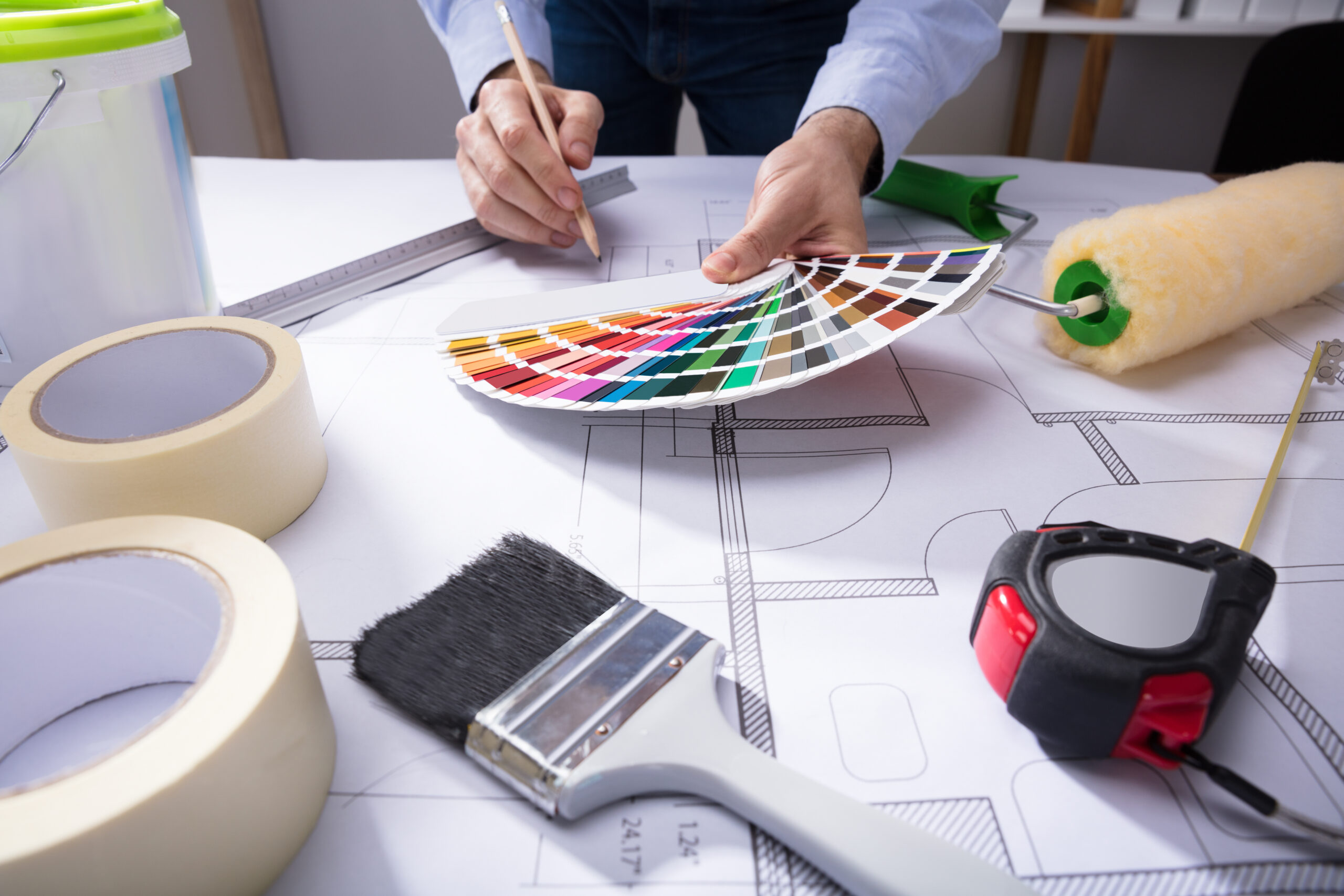
Architect's Hand Using Color Guide Swatch While Drawing Plan On Blueprint With Pencil
Revamping your living space is an exciting endeavor that can breathe new life into your home. However, the path to your dream remodel isn’t always clear-cut. Whether you’re modernizing a kitchen, renovating a bathroom, or overhauling an entire house, starting with a well-crafted checklist can be your secret weapon. This guide is designed to streamline your project, helping you manage every aspect with confidence and clarity, so you can transform your vision into reality without the stress.
Assess Your Needs and Set Goals
Before diving into any renovation project, it’s essential to conduct a thorough assessment of your needs and set well-defined goals. Begin by walking through your home and identifying the specific areas that require attention. Take notes on structural issues, outdated designs, and any functional shortcomings you encounter. For instance, if your kitchen lacks efficient storage, make a note of that. Prioritize these areas based on their impact on your daily life and overall property value. This will help you focus your efforts where they matter most and ensure that you invest your resources wisely.
Next, establish clear objectives for what you want to achieve. Think about both short-term needs and long-term aspirations. Create a vision board or a mood board to visualize your desired outcomes, incorporating elements such as color schemes, materials, and layout ideas. Additionally, consider practical aspects like the project’s timeline, potential disruptions to your living situation, and budget constraints. Breaking your goals down into smaller, manageable tasks can also make the project feel less overwhelming and more achievable. By setting specific, detailed goals, you set the stage for a successful remodeling venture that aligns with your vision and satisfies your unique needs.
Create a Realistic Budget
Establishing a realistic budget is crucial for the success of your home remodeling project. Start by determining the maximum amount you’re comfortable spending and maintain a detailed breakdown of how you will allocate these funds. Begin with major cost categories such as materials, labor, permits, and design fees. For materials, differentiate between essential and optional items, and consider visiting multiple suppliers to compare prices and options. When budgeting for labor, obtain quotes from several contractors, ensuring they offer a detailed estimate including potential additional costs. Don’t forget to include permit fees, which can vary depending on the scope of your project and local regulations.
Additionally, it’s wise to set aside 10-20% of your total budget as a contingency fund for unexpected expenses that frequently arise during renovations, such as structural repairs or unforeseen complications. Break down your budget into phases or milestones to help track spending and make adjustments as necessary. Utilize budgeting tools or software to monitor expenses in real time, which can help you stay on track and avoid overspending. By meticulously planning your budget and keeping a close eye on expenditures, you’ll be better equipped to navigate the financial challenges of a home remodel while achieving your desired results without compromising quality or style.
Research and Gather Inspiration
Before making any design decisions, it’s important to immerse yourself in extensive research to find inspiration that aligns with your vision for the remodel. Start by exploring a variety of sources such as home improvement magazines, design blogs, social media platforms like Pinterest and Instagram, and TV shows focused on home renovation. These resources can provide a wealth of ideas on current trends, innovative materials, and various styles. Create a mood board that includes everything from color schemes and furniture styles to lighting fixtures and floor plans. This visual representation will help you clearly articulate your design preferences and ensure that all aspects of your remodel are cohesive.
In addition to gathering inspiration online, consider visiting local home improvement stores, showrooms, and open houses. Take note of materials, finishes, and design elements that catch your eye. Speaking directly with vendors and industry professionals can also yield invaluable insights into the practical aspects of your choices, such as durability, maintenance requirements, and cost-efficiency. For a truly personalized remodel, engage with an interior designer or architect who can provide expert advice tailored to your home. They can bring your vision to life by offering innovative solutions you may not have considered, ensuring that your remodel not only looks stunning but functions seamlessly within your space. By conducting thorough research and gathering a diverse range of ideas, you’ll be well-prepared to make informed decisions that transform your home into a reflection of your style and needs.
Hire Reliable Contractors
Finding the right contractors for your home remodeling project is crucial to its success. Start by researching and interviewing potential contractors, ensuring they have the right credentials, licenses, and insurance. Look at their portfolio of past projects to gauge their experience with specific tasks like roofing and siding, drywall, and flooring. For example, when hiring a roofing and siding contractor like R & T Roofing and Remodeling, ask to see their previous work on homes with similar styles and materials to ensure they can handle your specific needs. Similarly, contractors specializing in drywall and flooring should provide samples of their past projects, highlighting their skill in achieving smooth finishes and precise installations. Don’t hesitate to ask for references and contact previous clients to hear firsthand about their experiences.
Additionally, obtain multiple bids for the work to compare costs and services. Be wary of significantly low bids, as they may indicate subpar materials or workmanship. Instead, opt for contractors who offer detailed, transparent estimates that include potential additional costs and timelines. For instance, a reliable flooring contractor will break down the price of materials, underlayment, labor, and finishing. Discuss your vision, timeline, and budget with potential contractors to ensure alignment. A reputable contractor will communicate clearly, address any concerns promptly, and provide a well-defined contract outlining the scope of work, payment schedule, and warranty details. By selecting experienced, trustworthy professionals, you’ll set the foundation for a smooth and successful remodel that enhances the beauty and functionality of your home.
Obtain Necessary Permits
Before you commence any home remodeling work, it is crucial to obtain the necessary permits from your local building authority. Permits ensure that your renovation complies with regional building codes and safety regulations. Work with your contractor or architect to identify all the required permits for your specific project, which may include those for structural changes, electrical work, plumbing, or roofing. Failing to secure proper permits can result in fines, project delays, or even mandatory removal of completed work. Additionally, the permit process often involves inspections at various stages, ensuring that the work is conducted to code and any issues are addressed promptly.
Apart from securing permits, there are other regulatory requirements you need to meet, such as proper disposal of construction waste. Construction and demolition debris can be hazardous and must be disposed of in compliance with local guidelines. Consider hiring a junk removal service like JDog Junk Removal & Hauling that specializes in handling remodeling waste to ensure environmentally responsible disposal and recycling practices. These services can handle everything from old fixtures and drywall to large appliances, saving you time and ensuring that waste is managed appropriately. Additionally, make sure your contractor includes waste disposal as part of their service, or budget for a separate waste management plan. Addressing these logistical concerns proactively can help streamline your project, avoid legal complications, and minimize your environmental footprint.
Plan Your Timeline
Creating a detailed and realistic timeline is essential for ensuring your home remodeling project proceeds smoothly and stays on schedule. Begin by breaking the project down into key phases: initial planning, demolition, structural work, installations, finishing touches, and final inspections. Each of these phases should be assigned a specific start and end date. Collaborate closely with your contractors to outline a detailed schedule, taking into account their availability, the complexity of each task, and the estimated time for delivery of materials. Current industry lead times should not be overlooked, as high demand or global supply chain issues could affect material availability. Utilize project management tools or apps that allow you to track progress in real time, set milestones, and receive notifications about deadlines. This way, you can preempt any potential delays and adjust plans accordingly.
Remember to factor in buffer periods for unexpected setbacks. Delays can stem from various sources such as unfavorable weather, unforeseen structural issues, or shipping delays for materials. Allocate extra time for each phase, especially for tasks that are likely high-risk for delays, such as inspections or obtaining materials that may need to be custom-made. Additionally, coordinating timelines with multiple contractors can be challenging, so ensure clear communication and schedule overlap where possible to enhance efficiency. For instance, if you’re waiting for a flooring delivery, schedule plumbing work that doesn’t impede the floor installation. By meticulously planning your timeline with these considerations, you enhance the likelihood of staying within your projected timeframe and reducing stress throughout your remodeling journey.
Select Materials and Finishes
Choosing the right materials and finishes is key to achieving the desired look and functionality in your remodeled space. When selecting elements such as flooring, countertops, cabinetry, and fixtures, consider factors like durability, maintenance requirements, and aesthetic appeal. For instance, hardwood floors might provide a timeless look but will require regular maintenance, whereas luxury vinyl planks can offer a similar appearance with greater durability and less upkeep. Similarly, quartz countertops are popular for their resistance to stains and scratches, making them an excellent choice for busy kitchens. Visiting showrooms and consulting design professionals can provide valuable insights into the latest trends and best materials for your project.
An often overlooked yet crucial aspect of remodeling is the selection of paint colors and finishes. Engaging a professional interior painting contractor for a consultation can make a significant difference in your project’s outcome. Experienced experts like Atlanta Painting Company can suggest color palettes that align with your vision while considering factors such as natural light, room size, and existing décor. For example, a painting contractor might recommend matte finishes for ceilings and semi-gloss for trims and doors to create contrast and highlight architectural features. Additionally, they can provide guidance on eco-friendly paint options that have low VOC levels, contributing to healthier indoor air quality. By leveraging the expertise of a professional, homeowners can ensure that their material and finish choices not only enhance aesthetic appeal but also contribute to a functional and cohesive living space.
Prepare Your Home
Before the start of construction, thorough preparation is essential to minimize disruptions and protect your living space. Begin by decluttering and removing all furniture, personal belongings, and valuable items from the work area. This not only protects them from damage but also provides contractors with an unobstructed workspace. For items that cannot be moved, such as large furniture pieces, use heavy-duty plastic sheeting or protective covers to shield them from dust and debris. Additionally, protect floors, walls, and other surfaces with contractor’s paper, drop cloths, or temporary plywood flooring. If possible, seal off the construction zone with plastic barriers to contain dust and prevent it from spreading to other areas of your home.
Creating a designated area for contractors to store their tools, materials, and supplies will help maintain organization and reduce the chances of misplaced items. Allocate a specific part of your home, such as the garage or a spare room, for this purpose. Set up easy access to waste disposal options, like a rented dumpster or dedicated bins, to keep the worksite clean and orderly. Communicate with your household members about the remodeling schedule, and establish safety guidelines to ensure everyone’s well-being throughout the construction period. Consider creating a contingency plan for essential daily activities, such as cooking or bathing, especially if the remodel affects key areas like the kitchen or bathroom. Clear communication and comprehensive preparation will pave the way for a smoother, less stressful remodeling experience.
Monitor Progress and Communicate Effectively
Staying actively involved in your home remodeling project is crucial to ensure everything proceeds according to plan. Schedule regular check-ins with your contractors, either through on-site visits or virtual meetings, to review progress and address any concerns. Keeping a detailed project journal can help you track daily updates, note any changes, and record conversations. This log will be invaluable for reference and clarifying details with your contractors at any stage. Utilize project management software to monitor timelines, budgets, and task completion in real time. Tools like Trello, Asana, or Buildertrend can offer transparency, allowing you and your team to stay aligned on priorities and deadlines. Consistent monitoring helps you catch potential issues early, such as material shortages or unexpected structural problems, so they can be addressed promptly.
Effective communication is the backbone of a successful remodel. Establish a clear communication plan with your contractors. Agree on primary points of contact, preferred communication methods (calls, emails, or messaging apps), and response times for inquiries. Hosting regular team meetings, even if brief, can ensure all parties are updated on progress, upcoming tasks, and any adjustments needed. Be specific and proactive when discussing changes to the project scope; articulate your expectations clearly and seek confirmation that your contractors understand your vision. Furthermore, having a contingency plan for dealing with disruptive issues, such as weather delays or sudden material unavailability, can mitigate stress and keep your project on track. By fostering open, regular communication and staying closely involved in monitoring progress, you can navigate challenges more effectively and ensure your remodeling journey is a success.
Inspect Workmanship and Make Final Touches
Upon the completion of construction, it is critical to conduct a meticulous inspection of all workmanship to ensure that every aspect of the renovation adheres to your predetermined standards. Begin by creating a comprehensive checklist that includes all the tasks outlined in your contract. Walk through each area of your remodeled space with this checklist in hand, paying close attention to the quality of finishes, installations, and any custom features. Look for common issues such as uneven paint lines, misaligned tiles, or improperly installed fixtures. Using a flashlight can help you spot imperfections, especially in dimly lit areas. Don’t hesitate to bring up even minor discrepancies with your contractors, as addressing these early can prevent more significant issues down the line.
In addition to visual inspections, consider functional tests of all new installations. Check the opening and closing of doors and windows, the functionality of electrical outlets and switches, and the performance of plumbing fixtures such as sinks, showers, and toilets. For a more detailed evaluation, you might enlist the help of a third-party home inspector, especially if the renovation involved substantial structural changes. This can provide an impartial assessment and highlight any issues that might have been overlooked. Once you are satisfied with the workmanship, work on adding personal touches to infuse your personality into the space. Integrate decor items, such as artwork, plants, and textiles, that complement your new design. This not only enhances the aesthetic appeal but also helps you feel more connected to your newly remodeled home. Addressing these finishing touches ensures that your renovation not only meets your functional needs but also provides an inviting and cohesive environment.
By following this comprehensive checklist for home remodeling projects, you can navigate the renovation process with confidence and achieve stunning results. Remember that each step, from securing permits to making final touches, plays a crucial role in the overall success and satisfaction of your remodel. Take pride in your attention to detail and proactive planning—it goes a long way in ensuring that your vision becomes a reality. Whether you’re tackling small updates or embarking on a large-scale renovation, your thorough preparation and clear communication with contractors will set you up for a smoother, more enjoyable experience. Embrace each phase with a sense of accomplishment, knowing that your dedication and effort are paving the way for a beautifully transformed living space. Happy remodeling!


